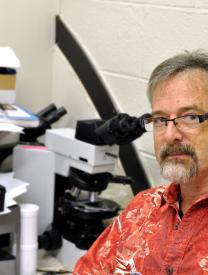Instrumentation in EES
The Department has a number of analytical instruments and equipment for sample preparation. Many of these see heavy use and need to be reserved in advance. These include The ICP-OES, the Elemental Analyzer, microbalance, Particle Size Analyzer and XRF. Please use the following link to access the reservation calendar: E&ES Instrument Reservation
Ph.D. University of Pennsylvania 1993 Ecology
M.S. University of Oklahoma 1982 Plant Physiology
B.S. University of Oklahoma 1980 Botany
Biogeochemical cycling of nitrogen and phosphorus in forested ecosystems
I have been involved in research that shows strong relationships between available nutrients and soil carbon. This suggests that forests create soil conditions favorable to their maintenance; consequently, nutrient limitation may not exist in the form frequently postulated. Nonetheless, there are soils, particularly in boreal and sub-boreal forests, which have low potential/actual mineralization rates. Growth in these forests is generally strongly correlated with climate, rather than soil parameters. This suggests that conventional measures of mineral N availability may not be adequate to assess N availability in these forests. It is likely that these forests are cycling a significant amount organic N. Consequently, I am interested in examining the importance of mycorrhizal associations in nutrient acquisition. In particular, I have been studying how mycorrhizal associations may provide access to organic pools of N in ecosystems with low mineral N availability.
Physiology of high-latitude ecosystems
There is considerable fossil evidence for the presence of extensive forests in the high latitudes at earlier times in the earths history. There are remains of large forests above the Arctic Circle, raising questions about adaptations required to live in conditions of continuous light and extended periods of dark. This includes issues such as energy gain under the low light angles, as well as how the day/night cycles and light wavelengths affect phenology. Reconstruction of such forests should also give us insight into the climate under greenhouse conditions, providing some indication of future changes in the modern earth, and whether current species are adapted to occupy higher latitudes. As a part of this research, I am currently examining the physiological ecology of Metasequoia glyptostroboides, a gymnosperm formerly widespread throughout North America.
Evolution of deciduousness in Gymnosperms
Prior to the Holocene glaciation, seasonality occurred as light vs dark, rather than cold vs warm. Deciduousness is common in Angiosperms, and appears to have arisen in response to more than one environmental signal, probably both drought and dark. Deciduousness is rare in the Gymnosperms, and it is not clear what environmental condition selected for deciduous forms. The deciduous gymnosperm taxa include Laris/Pseudolarix in the Pinaceae and Taxodium/Metasequoia in the Taxodiaceae. These taxa are associated with wet soil conditions, so drought-deciduousness seems unlikely. These taxa may have evolved deciduousness at high latitudes in order to prevent carbon loss due to respiration during the dark periods at above-freezing temperatures.
Forest growth and climate
A compilation of forest growth rates and climate for a large number of forests around the globe indicates that growing season length and temperature account for most of the variance in growth between widely varying forests. (e.g. between tropical and boreal forests) This effect is most likely a result of direct temperature effects on the physiology of the tree, that is, warmer canopies fix more carbon, so there is more growth. However, in light of the current paradigm explaining growth rates as a consequence of nutrient limitations, an alternate explanation exists. It is possible that the temperature effect is indirect, a result of differences in soil temperatures, causing differences in microbial activity, hence mineralization rates. In this manner, warmer environments provide a greater nutrient availability, resulting in faster annual growth rates.
Plant physiological responses to environmental stress, especially in an evolutionary context
Plants have evolved a variety of responses to environmental stress, ranging from biochemical to physical strategies for avoidance or tolerance. I am particularly interested in biochemical strategies involved in tolerance of pests and drought.
ENVS 605 Bioremeditaion; GEOL 604 Geostatistics; GEOL 608 Instrumentation for the Geosciences

